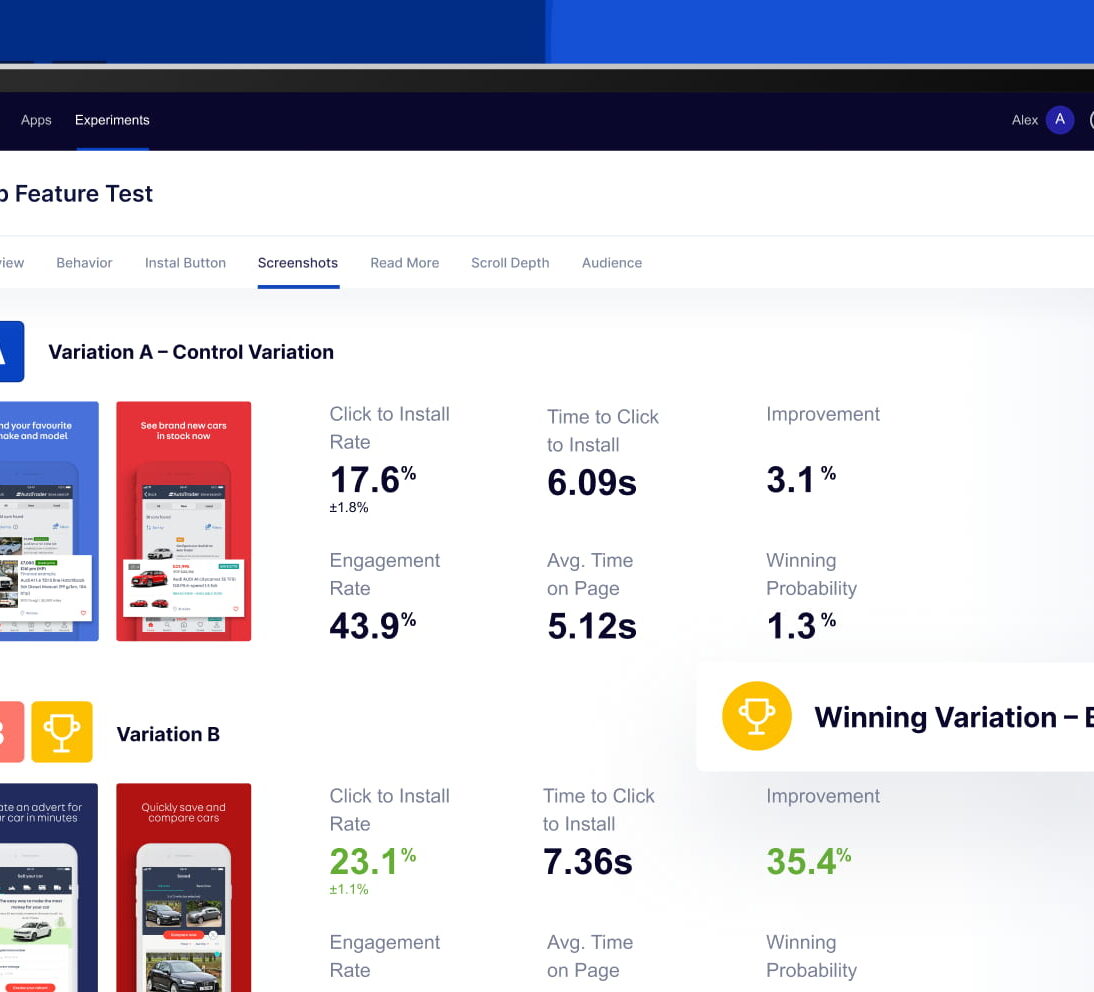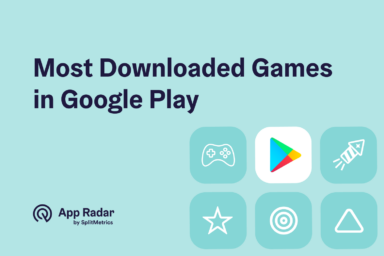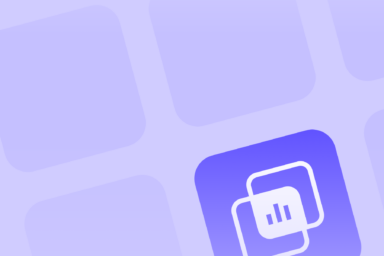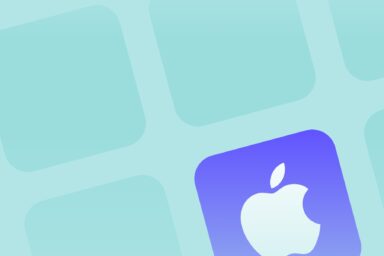Beginner’s Guide to A/B Testing for ASO on the App Store & Google Play
A/B testing for App Store Optimization (ASO) is the process of comparing two or more variations of an app's store listing or product page to determine which version performs better. The endgame is achieving a higher conversion rate (CR), which leads to more app downloads and, consequently, better profitability for any user acquisition channel.

A/B testing enables data-driven decisions, eliminating costly and time-consuming guesswork. Both leading app marketplaces, the App Store and Google Play, offer their native A/B testing functionalities. Advanced solutions like SplitMetrics Optimize significantly expand them, offering more metrics and options, like pre-launch testing.
There are enough A/B testing methods that any app should consider them an essential part of its ASO strategy and replicate the agency’s success for texPlus (or many more). Here’s how to do it.
Why is A/B testing critical for ASO?
A/B testing for app store optimization (ASO) on Google Play and the App Store is focused on optimizing a product page or a store listing’s impact on the conversion rate. It’s relevant for both organic and paid user acquisition.
In general, A/B testing is a critical component of understanding your audience in a target market, having a significant impact on app localization and seasonal updates.
A/B testing will increase your CR and ROI because it will allow you to ground your design in real, current data, resonating with your audience best.
The impact of A/B testing for ASO is especially powerful for Apple Ads or Google’s App Campaigns. For example, careful optimization of creative components of a product page can lead to a synergistic effect between ASO and Apple Ads, as search results ads utilize product page creatives directly, and overall product page performance is a factor in determining their relevance.
To summarize, A/B testing for ASO is crucial, as it can impact all user acquisition channels. Without further ado, let’s examine how they can be run.
How to run A/B tests for ASO
There are two methods of running A/B tests for ASO:
- Native testing feature of a given marketplace
- External platforms
On the App Store, it’s Product Page Optimization (PPO), a feature of App Store Connect. On Google Play, Store Listing Experiments are available in the Google Play Console.
What exactly can you A/B test on app marketplaces?
In general, an ASO specialist or an advertiser can A/B test any component of a product page or a store listing. Naive features have some limitations. For example, the app’s name can only be changed with a significant update to the app. Here’s a brief comparison of these native features with SplitMetrics Optimize, our A/B testing platform:
| Element to A/B Test | App Store (PPO) | Google Play (CSL) | SplitMetrics Optimize |
| App icon | Yes | Yes | Yes |
| Screenshots | Yes | Yes | Yes |
| App previews (Videos) | Yes | Yes | Yes |
| App name | No | No | Yes |
| Subtitle | No | Not Applicable | Yes |
| Short description | Not Applicable | Yes | Yes |
| Full description | No | Yes | Yes |
| Feature graphic | Not applicable | Yes | Yes |
| Localization | Yes | Yes | Yes |
| Number of variations | Up to 3 | Up to 3 | 8 |
| Audience | Random segment of organic users | Random segment of all users visiting the listing | Any paid UA channel |
| Review process | Yes | Yes | None |
| Test duration | Up to 90 days | Minimum 7 days | Methodology-dependant |
There are two things to remember:
- The fact that you can test an element doesn’t mean that doing so is justified in terms of a possible CR uplift.
- Although free, both native features offer no flexibility in terms of traffic driven to the tests, which may negatively impact the trustworthiness of the results.
There are more caveats to using these free native services, primarily in what they don’t do. Let’s compare them with our platform in more detail.
When to use an external platform to run A/B tests?
Let’s consider the following:
| Feature | SplitMetrics Optimize | Native feature |
| Pre-Launch Testing | Yes | No |
| Testing methodologies | Bayesian, Sequential, Multi-Armed Bandit | Bayesian |
| Approval Process | No | Yes |
| Targeting & Traffic Control | ICP Targeting, Traffic Routing, Custom Requests | No |
| Result Accuracy | Level of confidence under control | High level of inaccuracies |
| Testing Environments | Product Page/Store listing + Search & Category (competitive environment) | Product page or store listing |
| User Behavior Analytics | 50+ Detailed Metrics | Limited (3 metrics) |
| Simultaneous Experiments | Unlimited | Limited |
Running A/B tests with an external service provides more flexibility in choosing traffic sources, allows for testing a product page before an app is even released, and ensures that the results are statistically significant. Detailed performance metrics will enable testers to draw meaningful conclusions about user experience and usability, even from tests that negate a hypothesis or end without a decisive winner.
Can I use custom product pages or store listings in testing?
Custom product pages (App Store) and custom store listings (Google Play) are alternative versions of your app’s main product page, created to target specific user segments.
These are used primarily to align the content a user sees on the app store with the content they saw in an ad or a specific marketing channel, thereby creating a more personalized experience and increasing the conversion rate from an ad click to an app install.
Their versatility and flexibility mean that app marketers effectively utilize them to try different designs or run A/B-style tests (an actual A/B test requires splitting a single, randomized audience to show them different variants, with all other conditions being equal). There is one thing to consider, though.
An advanced A/B testing platform running tests under scientific rigor will offer the best, statistically sound results with high confidence. Different testing methodologies help make even elaborate experiments relatively short.
The key argument with experiments done with CPPs or CSLs is convenience. You simply introduce new designs for particular keywords or advertising channels and try them out one after another.

When can you A/B test an app’s page?
You can A/B test your app even when it’s nothing more than a few sketches by your designer or visualisations prepared with the help of generative AI, provided you have the right solution that enables that. When you choose to A/B test, your app bears a significant impact on methodology.
Pre-launch
Pre-launch A/B testing is possible with external, specialized tools like SplitMetrics Optimize, significantly contributing to an app’s development or even conceptual phases. It can be used to determine which creative direction to take.

The capability extends to A/B tests shortly before a release, during a beta phase, where the app’s App Store or Google Play presence is fine-tuned to maximize the impact of a launch.
Post launch
The most critical times to consider A/B testing for your app’s store listing are before major holiday seasons and during periods of significant app updates.
- Before holidays and seasonal events: Special events have their own design trends that change year to year, and A/B testing is critical to creating best-performing holiday campaigns.
- Before major app updates: The case of Hobnob rebranding and changing its logo, which consequently led to a decline in conversion rates, should serve as a warning against design decisions based on intuition rather than data.
However, A/B testing can and should be a continuous process integrated into your strategy, as you will likely evolve your pages/listings in iterations.
What are the different A/B testing methodologies?
Both Product Page Optimization (PPO) in App Store Connect and Store Listing Experiments in Google Play Console utilize a fixed methodology to run A/B tests, which is warranted by their focus.
For comparison, SplitMetrics Optimize employs multiple A/B testing methodologies to analyze data and determine a winner. Each has its own strengths and is suited for different types of tests (for example, the multi-armed bandit is optimal for seasonal experiments). Here’s a comparison of A/B testing methodologies available on the platform:
| Bayesian | Sequential | Multi-armed bandit | |
| Best for | Live apps, periodic & minor changes | Pre-launch, big changes & ideas | Seasonal experiments |
| Traffic allocation | Randomly & equally | Randomly & equally | More to the best variation |
| Interpretability | Improvement level, winning probability, chance to beat control | Improvement level, confidence level | Weight |
| Key benefit | The golden middle methodology | High confidence | Speed & low cost |
Choosing the proper methodology for a goal will help optimize the costs of acquiring traffic for tests, as well as increase the confidence level of your results. Their inclusion reflects the wider range of possibilities SplitMetrics offers.
What should you A/B test on app marketplaces?
Not all components of a product page or a store listing are equally important for conversion rate uplift, and the fact that you can doesn’t mean you should. After countless tests run by our team, we can confidently point to the elements of pages/listings as critical, in this order:
- Screenshots: The fantastic case of textPlus gaining over 119k+ downloads as a result of a single A/B test is evidence of the tremendous impact good app screenshots have on conversion rates and, consequently, downloads.
- App icon: The app icon is the most critical element to test because it’s the first thing users see, whether in search results, on a featured list, or on the app’s product page itself.
- Preview video: These visual assets are highly prominent on both app stores. They are designed to grab a user’s attention immediately and showcase the app’s core value.
Additionally, the feature graphic on Google Play may be another critical asset for that marketplace, while the App Store’s designs should put special emphasis on effective app screenshots.
How to design A/B tests?
How to identify and select elements for testing? How to get statistically significant results, especially with low traffic, for as little money as possible?
The technical side of running an A/B test is easy; designing and implementing an actual test requires a solid framework that puts creativity on the right track. Let’s take a look at the official A/B testing & app validation framework, followed by SplitMetrics:
The official SplitMetrics’ app validation and A/B testing framework:
- Research your competitors, market, and audience;
- Ideate all the elements you could test;
- Form a hypothesis;
- Select variations;
- Design an experiment;
- Analyze the results;
- Share your findings;
- Go back to stage 3!
First, it begins with research, with ASO competitive research being a critical part. Creative optimization with A/B testing for ASO never takes place in a vacuum. A product page should be immediately understood within its category, yet be distinct enough to capture attention and incentivize a download.
Second, following this order will guide your designers to make changes with potential impact on conversion rates, grounded in data and a good understanding of user preferences and journeys.
How to select the correct elements for A/B testing?
What you want to test largely depends on when you’re running your experiments. For example, while prototyping, you may compare significantly different designs, even multiple ones, as a form of market research. Rockbite’s mobile game validation mentioned earlier is an excellent example of this practice.

A/B testing for a live app is an iterative process, where the elements with the most significant impact are selected first. Logically, these may be the focal points of each component:
- A particular character to be featured on an app’s icon;
- A person, image, or feature to be displayed on the first screenshot;
- A key message to be displayed on the first screen.
A reasonable hypothesis connects a specific element to a change in conversion rate. It largely depends on what particular product page creative you’re testing, so let’s review them and provide some examples.
Screenshot testing
Screenshots, with design grounded in data and user preferences, are critical for conversion rates. Visible in both search results and on the product page, the right choice of screenshots can have a tremendous impact on your results. Here are some examples of what you can test:
- The first screenshot: Test different core messages and value propositions. Which feature of your app is the primary, most popular one? Which call to action works best?
- Text overlays on screenshots: A feature-driven caption might say, “A workout tracker.” A benefit-driven caption would say “Track your workouts, effortlessly.” Test which style resonates more with your audience.
- The order and number of screenshots: Even with the same set of screenshots, their order can change your conversion rate. Put your most compelling screenshots first. Most users only view the first few.
- Visual style: Test different backgrounds, solid colors, gradients, or images. Certain apps can test horizontal vs vertical layouts

Screenshot optimization is critical on the App Store, where the first one occupies a significant part of the screen. Additionally, device uniformity incentivized some unique design patterns (like panoramic screenshots) that might not work as well on Google Play. It’s one of many reasons to creat these marketplaces individually in terms of screenshot optimization.
App icon testing
A sound app icon communicates the purpose of your app immediately, while standing out from the crowd. It’s essential to track and optimize tap-through and conversion rates. Here are some directions your A/B tests can go:
- General visual concept: Symbol vs. abstract, like a camera lens for a photo app against one that uses a more abstract, brand-focused visual.
- Brand vs. Function: For established brands, you could test an icon that is purely your logo against one that includes a small element hinting at the app’s use case.
- Test Color and Style: Color Palette, Shadows and Gradients, presence of text and language.
Preview video testing
A/B testing a preview video is about optimizing the first dynamic impression a user has of your app. These videos are crucial because they autoplay silently, receive priority placement over screenshots, and can quickly convey your app’s core value. Here are the key elements to an A/B test for your app preview video:
- The Thumbnail (or Poster Frame): Test different designs, text overlays, or even a still from a different part of the video.
- The First 3-5 Seconds: Statistically, you have a very short window to capture a user’s attention. Try starting the video with different scenes. Does a high-energy action scene perform better than one showing the app’s UI?
Additionally, consider testing whether to use a preview video at all, because not all apps need them. For highly focused apps, a screenshot might well do the trick.
How to acquire traffic for A/B testing?
Choosing the right paid user acquisition (UA) channels for A/B testing when there is insufficient organic traffic to meet the minimum sample size criteria in a reasonable time, or there can be no organic traffic, as with pre-launch tests.
Not all advertising platforms will be equally effective for all apps. The channels selected should align with your app’s target audience. For example, if your app is a short-form video editing tool, your target audience is likely active on TikTok and Instagram, making these platforms high-priority for testing.
Ad channel validation is also a significant direction of A/B testing. You can sample audiences from a multitude of channels before ultimately committing your resources to the most profitable ones and suitable for your particular type of app.
How long should I run an A/B test?
You should run an A/B test long enough to reach a specific level of confidence in the results. There’s actually quite a lot of science behind that question and what the minimum sample size is for effective and accurate tests. SplitMetrics Optimize operates on these principles, automating the process, leaving you with only the task of driving traffic through any means you need.
In the case of our platform, the time required to reach a specific confidence level depends on the A/B testing methodology, which in turn should be tailored to the thing being tested. The design of the test itself can also have an impact. Significant differences between variations may contribute to the result emerging more quickly and decisively.
The rule is that high traffic will make your tests shorter. In general, quick, multi-armed bandit tests before holidays can be resolved in a week. Complex, sequential tests can run for a month. Custom product pages can be swapped in one-month cycles.
How to interpret the results, and what to do with them?
How to interpret the results of an A/B test? Let’s examine three possible outcomes:
- One of the variations is a clear winner: Congratulations, you may proceed to implement the variation for a broader audience.
- The current version performs better: Don’t fret, it’s still a valuable learning experience! The question becomes, “Why did this variation fail?” and “What did I learn about my audience from the test?” The results can guide you to the next hypothesis.
- There’s no clear winner: This situation doesn’t necessarily mean the test was a failure; instead, it provides valuable data indicating that the tested elements did not significantly impact conversion rates. Further analysis of user behavior or a re-evaluation of the hypothesis is recommended.
Analyze any performance metrics you can on the variations to learn as much as you can about your audience, regardless of test results. Screenshot scroll depth, product page scroll depth, taps. All of these can push you toward a new hypothesis. This is the reason SplitMetrics Optimize’s additional metrics make each test a success, as they leave you with important insights about your audience.
TL;DR, or 10 quick tips for beginners
A/B testing may seem complicated, but it’s not, provided you organize your work within the proper framework. Mastered, it can unlock spectacular results, critical to the effective and profitable scaling of your app. To wrap up, here are 10 tips for A/B testing for beginners, capturing the message of the article:
- Formulate a clear hypothesis: Base it on analytics or user feedback.
- Prioritize high-impact elements: Focus on icons, screenshots, and preview videos.
- Test one variable at a time: Isolate changes to understand their impact.
- Understand your audience: Tailor creative assets to their preferences.
- Ensure sufficient duration and traffic: Allow enough time (e.g., 7-14 days) and a sample size that is statistically significant.
- Analyze beyond conversion rate: Examine metrics like tap-through rate for deeper insights.
- Embrace “losing” tests: View them as valuable learning opportunities.
- Maintain continuous testing: Integrate A/B testing as an ongoing optimization process.
- Study the market: Understand category trends and competition.
- Benchmark your app: Use ASO reports to gauge “good” conversion rates and inform testing priorities.
Final words
A/B testing is vital for app growth, transforming guesswork into data-driven success. By embracing continuous optimization and leveraging powerful tools like SplitMetrics Optimize, you can unlock your app’s full potential. Start experimenting today to maximize conversions and achieve profitable scaling!

Latest Posts

Top 10 Most Downloaded Games in Google Play Store (July 2025 Update)
Google Play Store Listing Experiments: How to Run Native A/B testing for Android Apps for Free!
12 Best Mobile Measurement Partners (MMPs) to Consider for Your Mobile App Attribution in 2025
Custom Product Pages: How to Boost App Store Conversions With Precise App Store Targeting
Academy Lessons
Continue lessons


